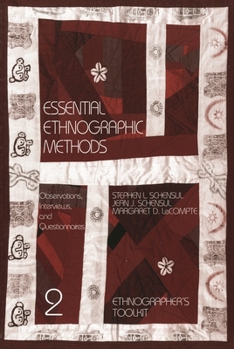Essential Ethnographic Methods: Observations, Interviews, and Questionnaires (Ethnographer's Toolkit)
(Book #2 in the Ethnographer's Toolkit Series)
Select Format
Select Condition 
Book Overview
A newer edition of this book is available for ordering at the following web address: https: //rowman.com/ISBN/9780759122017
Like all books in the Ethnographer's Toolkit, Book 2, Essential Ethnographic Methods, takes a mixed methods approach to introducing the fundamental, face-to-face data collection tools that ethnographers and other qualitative researchers use. Book 3 provides ethnographers with tools to answer basic ethnographic questions about the setting, activities, behavior, communication patterns of participants, and more. It teaches readers how to do good ethnography by walking them through the required steps for each essential method, and supplements this information with hands-on materials and illustrative case examples. Because these data collection strategies require ethnographers to become involved in the local cultural setting and to acquire hands-on experience, the essential tools also help them learn about new situations from the perspective of an "insider."The chapters cover open-ended and focused listening, questioning strategies, participant and non-participant observation, recording techniques, visual recall, strategies for mapping the environments and contexts in which participant behavior occurs, and varied approaches to individual- and group-level in-depth interviewing. Unlike most methods texts, Book 3 also examines how and why to carry out ethnographically informed qualitative and quantitative survey research. It also provides the basis for quantification of qualitative research for those who wish to do so. Research methods are sequenced in accordance with early, middle, and later stages of a research project, making it easy for readers to select different data collection methods for specific purposes and timelines. This mixed methods approach is emphasized because it is the only way that are ethnographers able to obtain the holistic portrayal of dynamic social systems and cultural phenomena that characterize the best ethnographies.
Format:Paperback
Language:English
ISBN:0761991441
ISBN13:9780761991441
Release Date:August 1999
Publisher:AltaMira Press
Length:344 Pages
Weight:1.26 lbs.
Dimensions:9.1" x 1.1" x 6.1"
Customer Reviews
1 rating
Ethnographer in training Review
Published by Thriftbooks.com User , 23 years ago
Over all, the book is well laid out, and the information is quite accessible. Example numbers and graphics set off the numerous case studies. Key points are given in italics and indicated with a graphic in the margin, where the reader will also find critical definitions and cross-references to chapters in other volumes in the series.This volume provides good introductory material on ethnographic fieldwork techniques. The methods are not given in isolation, but in relationship to theoretical models, and in terms of how operationalization may be done. Methodology is presented as coming directly from a theory, and feeding directly back into a modification of that theory, whatever that theory happens to be. The authors also clearly present the need for making observations operationalizable, allowing for observations to fit into a quantitative analysis that reflects the reality observed in a manner that is valid and reliable.Before moving to a direct discussion of the techniques, the authors give some needed practical information on getting to the field to do the research (chapter 4). This teaches the student how to avoid another common pitfall: having the technical tools to do the fieldwork, but not being able to get to the field or to survive there long enough to do the research.The next 140 pages of the book (chapters 5 to 9) give the basics of several types of ethnographic methodology: exploratory or open-ended observation; in-depth, open-ended interviewing; semistructured interviewing; structured ethnographic data collection (ethnographic surveys); and using archival and secondary data.The book finishes with two chapters (10 and 11), one on sampling, and the final one on validity and reliability. The volume ends with five full pages of references, and an eight-page index, which is subcategorized for easy reference.






